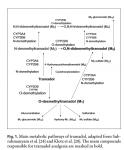Nicomorphinist
Bluelighter
Orphenadrine, nefopam, chlorphenamine and caffeine taken together and on top of hydromorphone (rotated with ketobemidone and nicomorphine once or twice a year, and assorted other middling and strong narcotic analgesics for breakthrough pain), naproxen, and paracetamol seem to do a very good job of subtracting out both the burning and lightning-like pain and it actually feels like the orphenadrine in particular and perhaps the nefopam seem to help the analgesics find the pain. Tripelennamine helps IM/SC morphine, oxymorphone and so on work better as well.
I had a bad reaction to gabapentin when it was prescribed as an adjunct to morphine a long time ago, and I have noticed that the orphenadrine-nefopam-chlorphenamine-stimulant combinations (the chlorphenamine used to have phenylpropanolamine in it) actually is a better gabapentin than gabapentin, at least in my case.
The anticholinergic + opioid combination is an old tried and true method to combat especially neuropathic pain. With stimulants as well, both to prevent orthostatic hypotension and strengthen the pain killing effect, as well as reduce somnolence. Hence Brompton Mixture, Scophedal, Paracetamol with Codeine with caffeine in it and oncologists and chronic pain doctors writing for methylphenidate, dextroamphetamine, or, back in the day, pyrovalerone.
Which adjuvants and potentiators work best for folks here?
MOD EDIT: Please don't copy & paste D-F articles with embedded links to D-F in them
I had a bad reaction to gabapentin when it was prescribed as an adjunct to morphine a long time ago, and I have noticed that the orphenadrine-nefopam-chlorphenamine-stimulant combinations (the chlorphenamine used to have phenylpropanolamine in it) actually is a better gabapentin than gabapentin, at least in my case.
The anticholinergic + opioid combination is an old tried and true method to combat especially neuropathic pain. With stimulants as well, both to prevent orthostatic hypotension and strengthen the pain killing effect, as well as reduce somnolence. Hence Brompton Mixture, Scophedal, Paracetamol with Codeine with caffeine in it and oncologists and chronic pain doctors writing for methylphenidate, dextroamphetamine, or, back in the day, pyrovalerone.
Which adjuvants and potentiators work best for folks here?
MOD EDIT: Please don't copy & paste D-F articles with embedded links to D-F in them
Last edited by a moderator:




